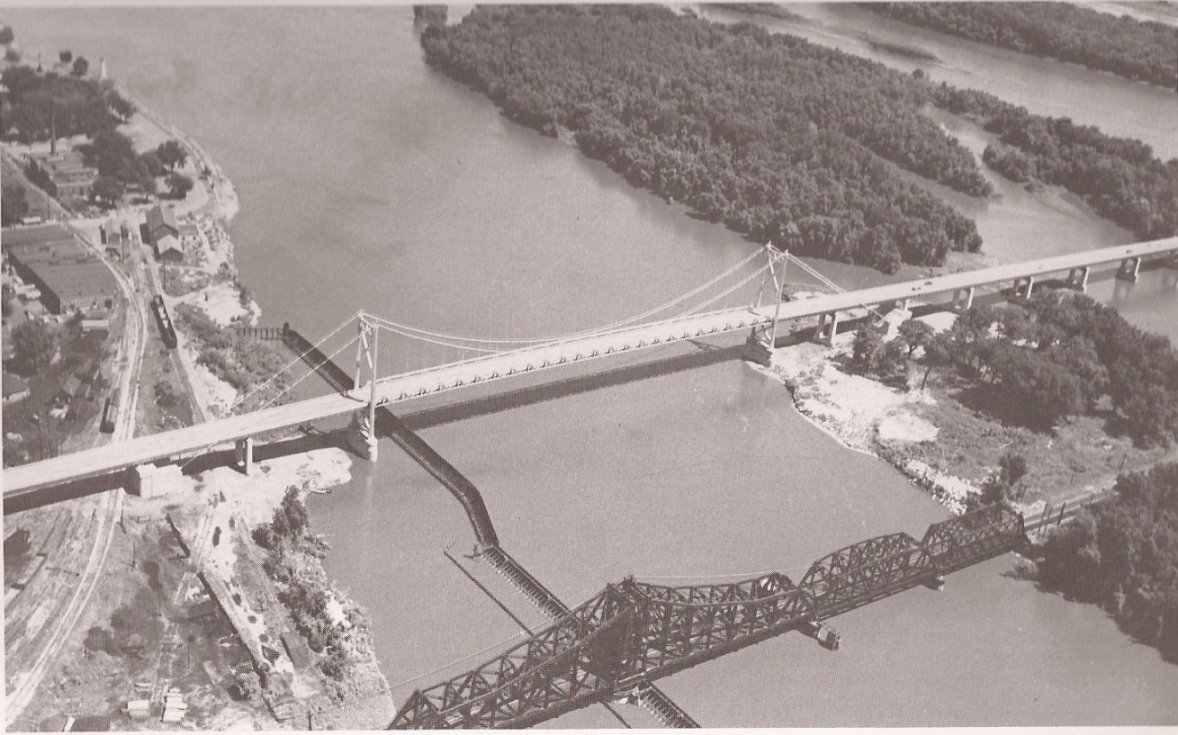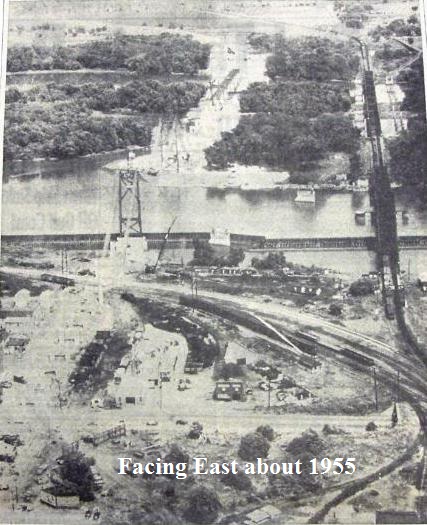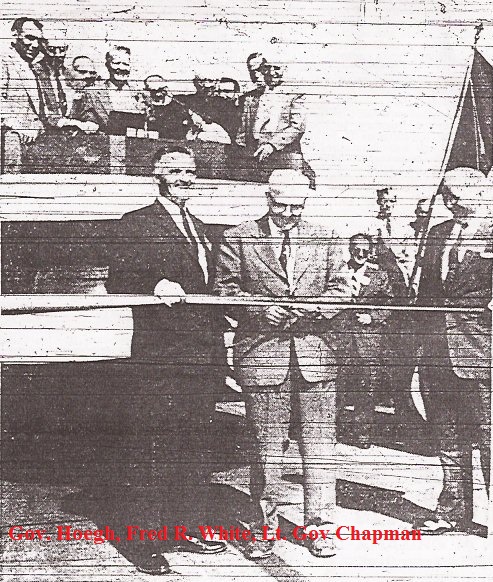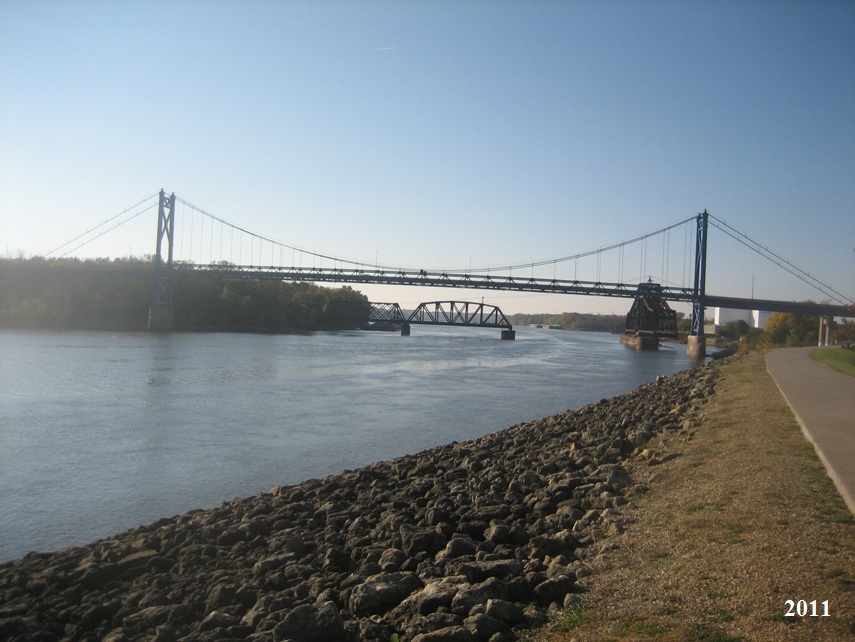Clinton's New Gateway Bridge - 1956
From: The Clinton Herald, Monday, July 2, 1956, P. 3
Transcribed by a Clinton County IaGenWeb volunteer.
9,000 Cars Move Bumper – to – Bumper Over Gateway Bridge Saturday.
Vehicles Jam City Streets.
Volume Believed Heaviest Ever.
 Traffic was reported running smoothly on the new Gateway bridge today after
motorists “crowded” bumper to bumper on the $6,800,000 span for about six hours
following the historic ribbon-cutting ceremonies Saturday afternoon. City
traffic in the vicinity of the two-mile structure and extending as far west as
Clinton high school was believed to be the heaviest in Clinton history as
citizens crossed the new span at a snail’s pace during the toll-free period from
about 4 p. m. to midnight Saturday night.
Traffic was reported running smoothly on the new Gateway bridge today after
motorists “crowded” bumper to bumper on the $6,800,000 span for about six hours
following the historic ribbon-cutting ceremonies Saturday afternoon. City
traffic in the vicinity of the two-mile structure and extending as far west as
Clinton high school was believed to be the heaviest in Clinton history as
citizens crossed the new span at a snail’s pace during the toll-free period from
about 4 p. m. to midnight Saturday night.
Officials estimated that around 9,000 vehicles crossed the new bridge during the
eight-hour period on Saturday. They also pointed out that persons in more than
3,000 vehicles paid toll and crossed the north end Lyons – Fulton bridge during
that same time.
Numerous State Highway Patrolmen and 11 or 12 city policemen steered the
enormous volume of traffic in the vicinity of the new bridge and kept the
situation under control from shortly after 4 p. m. until the pace began to
slacken around 10 o’clock Saturday night.
“It was unbelievable,” said one of the Clinton police who guided the motorists.
“You simply had to be out in it to appreciate how heavy it was. It was about
twice as heavy as the tie-up during Centennial time.”
Police pointed out that much of the difficulty stemmed from the fact that
motorists from both directions were merely crossing the bridge and then making
U-turns to go right back across.
Police said that cars were lined up as far out as Clinton high school waiting to
get across the bridge.
Despite the bumper – to – bumper situation no mishap was reported to Clinton
police as a result of the flow of traffic to and from the bridge.
The enormous stream of cars began to traverse the new span shortly after Fred
White, former chief engineer for the Iowa Highway commission cut the red, white
and blue ribbon at the end of the dedication ceremonies.
The historic grand opening for the gigantic structure of steel and concrete was
held at the 8th Ave. and 3rd St. intersection under clear blue skies and a
blazing sun.
Police estimated that between 3,500 and 4,000 persons jammed the intersection
and its vicinity to hear the ceremonies which included principal talks by Gov.
Leo Hoegh and Illinois Lt. Gov. John W. Chapman.
 Gov. Hoegh said the new span was appropriately named Gateway, in as much as the
new structure is truly a gateway to growth, expansion, development and
prosperity. He termed the bridge a “masterpiece in engineering” and expressed
Iowa’s gratitude to the commission and the community for its role in the
project.
Gov. Hoegh said the new span was appropriately named Gateway, in as much as the
new structure is truly a gateway to growth, expansion, development and
prosperity. He termed the bridge a “masterpiece in engineering” and expressed
Iowa’s gratitude to the commission and the community for its role in the
project.
Lt. Gov. Chapman declared the completion of the new bridge will have a
considerable impact on the improvement of the economic and traffic pattern of
Iowa and Illinois. He said such a structure is a summing up of the rapid and
radical change in the physical environment that Iowa and Illinois have undergone
in little more than 100 years.
Congr. Henry O. Talle of the Second Iowa District, applying a Daniel Webster to
the new span, said, “This is something worthy to be remembered.”
The shining new bridge provided an impressive background for the numerous
dignitaries who approached in cars from the Illinois side of the river for the 3
p. m. ceremonies.
The dignitaries in the cars included Gov. Hoegh, Lt. Gov. Chapman, Senators B.
B. Hickenlooper and Thomas Martin, Congr. Henry Talle and Illinois Rep. Leo
Allen.
During the colorful ceremony, dads held their tots on their shoulders. Some
folds sat under parasols to beat the heat. Soda pop and ice cream were for sale
on the sidewalks.
B. M. Jacobsen was the master of ceremonies. Rev. Jerry Walcott, Lyons Methodist
pastor, gave the invocation and Msgr. E. F. Jackson, St. Irenaeus parish pastor,
the benediction. The Fulton, Ill., high school band, resplendent in red
uniforms, played at the program.

 The opening was a particularly memorable afternoon for 90-year-old William J.
Sikkema of Fulton, Ill., who in the company of his 80-year-old brother Jake,
walked the new bridge just as he did the old Clinton & Illinois span the day it
was opened and the day it went out of business.
The opening was a particularly memorable afternoon for 90-year-old William J.
Sikkema of Fulton, Ill., who in the company of his 80-year-old brother Jake,
walked the new bridge just as he did the old Clinton & Illinois span the day it
was opened and the day it went out of business.
The inauguration was indeed memorable, too, for 80-year-old Clarence Sweet of
Garden Plain, Ill., and his brother Sam, 83, of Fulton, Ill., who chugged across
the new Gateway bridge shortly after its opening Saturday in a 1914 car. The
ride was particularly significant to them because as children they had been the
first person to cross the old Clinton & Illinois bridge, which the new span
replaces.
That opening of the new Gateway Bridge marks the beginning of a new era of
progress and prosperity for Clinton and the surrounding area was the theme of an
address given Saturday night by Albert Wedeking, president of the American
Bridge Tunnel and Turnpike association at a banquet held in the Clinton Country
club.
A hospitality hour preceded the banquet.
Wedeking explained that he had been attending bridge opening ceremonies for 24
years but never had he encountered as many friendly people as he did while in
Clinton.
He emphasized that the new bridge was built at no cost to the taxpayers. “The
people who use the bridge will pay for it,” he declared, “and that is the way to
get improvements which are needed now.”
 He paid tribute to those men who had a part in the planning and building of the
Gateway Bridge, particularly members of the City of Clinton Bridge commission.
At the close of his address he presented gifts to the following commissioners:
Mark N. Morris of Clinton, chairman; J. J. Burke of Clinton, vice-chairman; Fred
G. Hansen of Clinton, secretary and treasurer; E. H. Cyaas of Clinton, Llewellyn
Fay of Clinton, Mark B. Morris of Ames, representing the Iowa State Highway
commission and Merton Memler of Dixon, Ill., representing the Illinois division
of highways.
He paid tribute to those men who had a part in the planning and building of the
Gateway Bridge, particularly members of the City of Clinton Bridge commission.
At the close of his address he presented gifts to the following commissioners:
Mark N. Morris of Clinton, chairman; J. J. Burke of Clinton, vice-chairman; Fred
G. Hansen of Clinton, secretary and treasurer; E. H. Cyaas of Clinton, Llewellyn
Fay of Clinton, Mark B. Morris of Ames, representing the Iowa State Highway
commission and Merton Memler of Dixon, Ill., representing the Illinois division
of highways.
B. M. Jacobsen was toastmaster at the banquet.
He read a letter from Vice-President Richard Nixon which expressed the writer’s
regret at not being able to attend the opening and congratulating the city on
completion of the bridge.
A tribute was paid three former members of the commission now deceased, Milton
Peaco, Neil Saunders, and Dr. T. B. Charlton. Short talks were given by Mayor A.
H. Dall, J. C. Wolfe, Clinton Chamber of Commerce president, Frank Masters of
the firm of Modjeski and Masters, U. S. Senator Thomas E. Martin, and U. S. Rep.
Henry O. Talle.
Introduced to the audience were: Fred R. White and Hugo Surman, former bridge
commissioners; Everett A. Streit, who designed the brochure distributed at the
banquet; W. E. Ellwanger, bridge manager; P. B. Holleran and Prentice Shaw of
the firm of Holleran and Holleran; C. W. Hansen and Harold Echoff of the firm of
Modjeski and Masters; Emory Loomis and John Butter of the Iowa State Highway
commission, Al Cheramy and Art Machande of the Clinton Labor Congress; Major F.
W. Ray of the U. S. Corps of Engineers; Harry Pape, Don R. Allison, William
Greene, John W. Carlsen and Harry Burlow, former mayors of Clinton; and
representatives of the A. C. Allyn Co., Chapman and Cutler, Northern Trust Co.,
and Dubuque Centennial, Davenport and Muscatine Bridge commissions.
Music during the dinner hour was furnished by the Clinton high school string
ensemble under the direction of Mrs. Roger Stoskopf.

